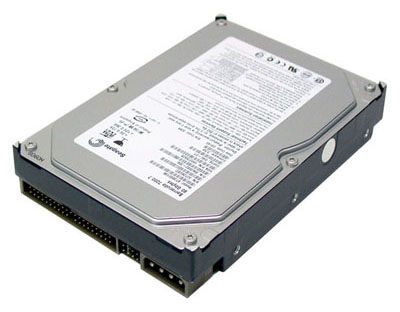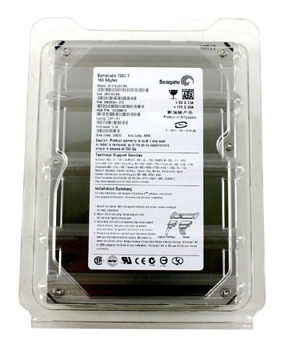Buyer's Guide - Entry Level, October 2004
by Jarred Walton on October 6, 2004 12:05 AM EST- Posted in
- Guides
Hard Drives
As with most of the other options, there are tons of potentially good hard drive choices. The three main factors that influence hard drive performance are the RPM, the amount of cache, and the capacity. While many might insist on a drive with 8 MB of cache, it is not strictly required for the budget segment, and getting a 2 MB cache drive can save you about $10. Getting a 5400 RPM drive instead of a 7200 RPM drive, on the other hand, is not recommended.The question of how much capacity you need is really up to the individual. Some people would never even manage to fill a 20 or 30 GB drive, while for others, even 200 GB may not be enough. These days, the cheapest hard drives still tend to cost about $50, and anything smaller than 40 GB will not be any cheaper. In fact, 80 GB drives are only slightly more expensive than 40 GB drives, and we feel that the extra $10 is worth it to double your capacity.
With most hard drives now spinning at 7200 RPM or faster, noise has become more of a concern. Particularly with an office computer, many people will find high noise levels to be distracting. Earlier 7200 RPM drives have been known to have a high pitch whine. Most companies have now upgraded to the latest spindle technology known as fluid dynamic ball bearings, which help to all but eliminate the noise of the hard drive. Many Western Digital Caviar and Maxtor drives use the older bearings and so, unless noise does not bother you, we recommend that you search out a drive that uses the fluid dynamic bearings. This is available on Hitachi, Maxtor, Samsung, Seagate, and Western Digital drives now, but take some time to make certain that it is on the model that you are purchasing.
One trend that we are happy to see is the return of longer warranties. For a while, many companies were shifting to 1-year warranties. Now, most of them have returned to 3- or even 5-year warranties on their drives. Seagate has led the way with a standard 5-year warranty on all of their models, including previously purchased drives! Others have only increased their warranty on current models. Just remember that the warranty only covers the physical hard drive, so you still need to make backups of your important files.
The final topic relating to hard drive choice is the interface. Parallel ATA - also called IDE or EIDE - has been around for a long time, so it tends to be slightly cheaper. The budget office motherboard that we recommended does not support anything else, but the gaming motherboard offers support for up to two Serial ATA connections. There is little to no difference in real world performance between the interfaces, at least in the budget segment, but SATA does use a thinner cable that is easier to work with. All things being equal, we would prefer a SATA drive over a PATA drive, and we would even be willing to pay a little more for it if necessary.

Office Hard Drive Recommendation: Seagate 80 GB 7200 RPM 8MB PATA
Price: $67 shipped
With all the considerations listed above, it is difficult to argue with the choice of a Seagate hard drive. You get the full five-year warranty (two years more than most of the competition), quiet operation, good performance, and plenty of storage. You could save a few dollars by choosing some alternative, but it just does not make a lot of sense. Should you need more storage space, models with 120 GB and 160 GB are available and have a lower cost per GB, but 80 GB should be plenty for even the most demanding office work.

Gaming Hard Drive Recommendation: Seagate 160 GB 7200 RPM 8MB SATA
Price: $107 shipped
Our recommendation for budget gamers remains with Seagate, due to their impressive set of features and reliability. The difference is that we have chosen to go with a SATA drive instead of PATA, and we have increased the recommended capacity to 160 GB. That may seem like overkill, but when you consider that Far Cry, Unreal Tournament 2004, and Doom 3 all require about 4 GB of hard drive space - and that's without any of the extra content that you can find online - it is very easy to run out of storage for your games. If you uninstall games that you are not currently playing, you can get around this potential difficulty, but that is not the most convenient of solutions. You can always downgrade to a 120 GB or 80 GB drive if you disagree. The cost per GB of an 80 GB SATA drive is 89 cents, while the cost per GB of the 160 GB drive is 71 cents. If you can afford it, you get double your storage space for about a 50% price increase.










53 Comments
View All Comments
Gholam - Wednesday, October 6, 2004 - link
Why not use an nForce2 IGP or KM400 based board and dump the discrete graphics card? Also, $73 case for an office system is waaaaay too expensive - an HEC 6CS3 with a 300W PSU will run you $30-35.Scarceas - Wednesday, October 6, 2004 - link
Ozenmacher - Wednesday, October 6, 2004 - link
I think for a budget office system, someone staring at a monitor all day may appreciate an LCD since they generally have better text and do not flicker. In that case, you can find 15 in LCD's online close to 200 dollars with integrated speakers. While integrated speakers suck, they would suffice for the office user and would reduce clutter. In that case, maybe another recommendation would be to subtract the 16 dollar speakers and add a little money towards an LCD for a slightly higher price. If they are really hurting for money, they definitely could subtract the video card as well.ceefka - Wednesday, October 6, 2004 - link
I second that #8. I like this new style too. Thank you Jarred for going the extra mile.Zebo - Wednesday, October 6, 2004 - link
#7 the best kept secret in ram is the crucial 8T, which Mwave sells also in thier bundles. This stuff can and will clock to 250 Mhz FSB and low timings. 3-3-3 1T. I've talked about it in various threads before and pointed here: http://www.ocforums.com/showthread.php?t=328636to show it's outstanding charachteristics.
Zebo - Wednesday, October 6, 2004 - link
Excellent work Jarred.I really like the idea of and your explinations of "alternative" goods. Like the monitor, 512 ram and 9800 pro. It gives users who may value of aspect or another, while considering thier intended use, some good clues.
DrMrLordX - Wednesday, October 6, 2004 - link
Interesting guide. I may follow some, if not all of these recommendations soon, if I can actually bear to part with money for a new system anytime soon.I was wondering if you've noticed mwave.com's deals on the Chaintech board you recommended, paired with Athlon 64s and Kingston memory(I think they have a few other brands available). The price on the three components together is very cheap, and could serve as an excellent base for a budget gamer(or overclocker) system.
You can get the above-mentioned combo(the RAM is 1x512 megs Kingston PC3200) for $292 + shipping. You get a free Farcry thrown in as well, and you get a better CPU than the Sempron 3100+.
Also, AMD is reportedly going to be dropping prices across the board on Oct 15. Best to wait 'til then if you're going to buy an AMD system.
ilancas - Wednesday, October 6, 2004 - link
JarredWalton - Wednesday, October 6, 2004 - link
Calin, certain flash USB devices can apparently be configured to function in place of a floppy drive. At least, that's what I've heard - I have never actually used one personally. Like I said in the article, it's worth the $10 for me. :DCalin - Wednesday, October 6, 2004 - link
"and installing hard drive controllers for XP are a couple of examples that often benefit from the presence of a floppy drive"Hello, there is no other way to install a driver for an unusual controller - even in Windows 2003. If you don't have a floppy, you're out of luck
Calin